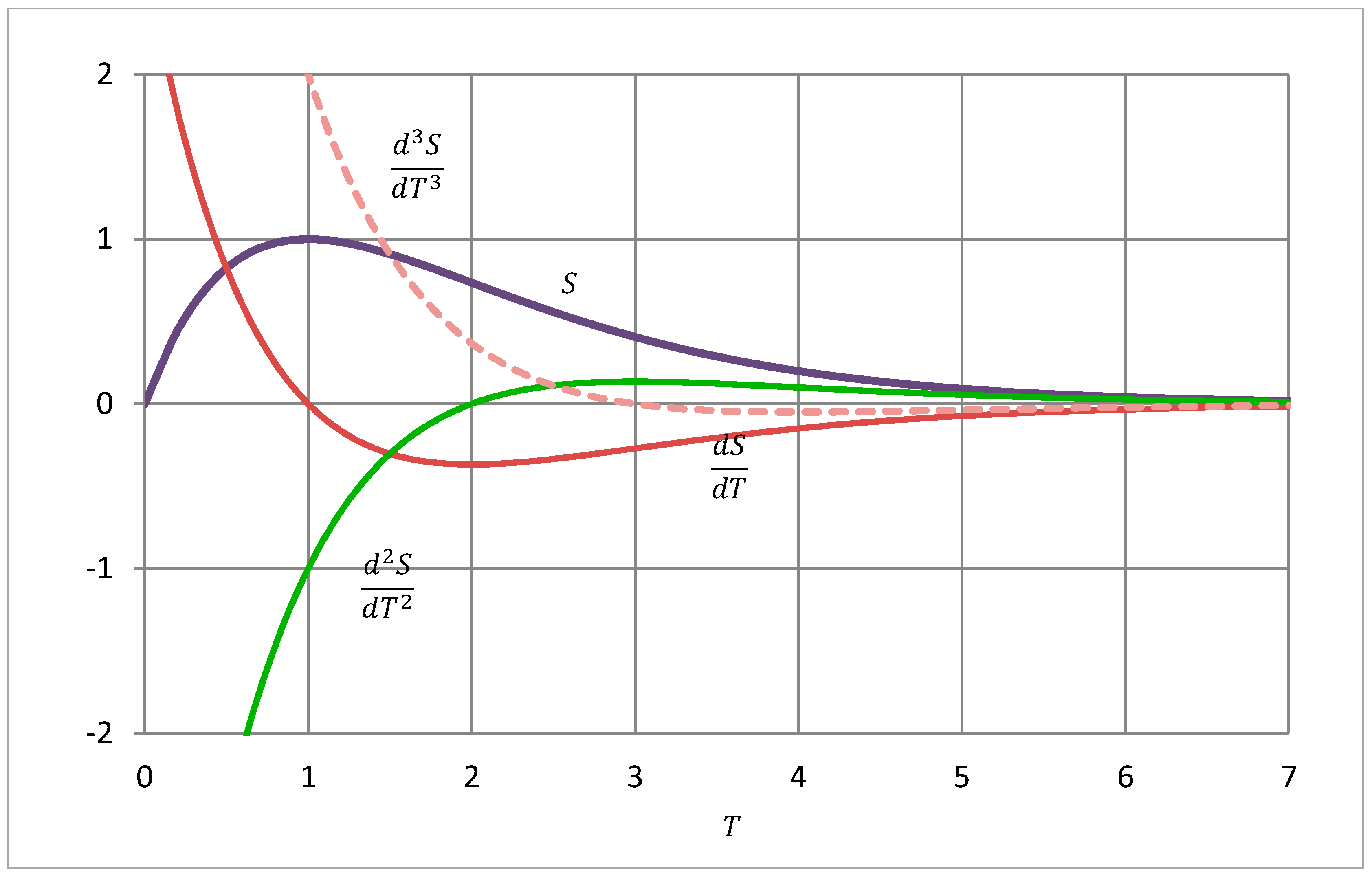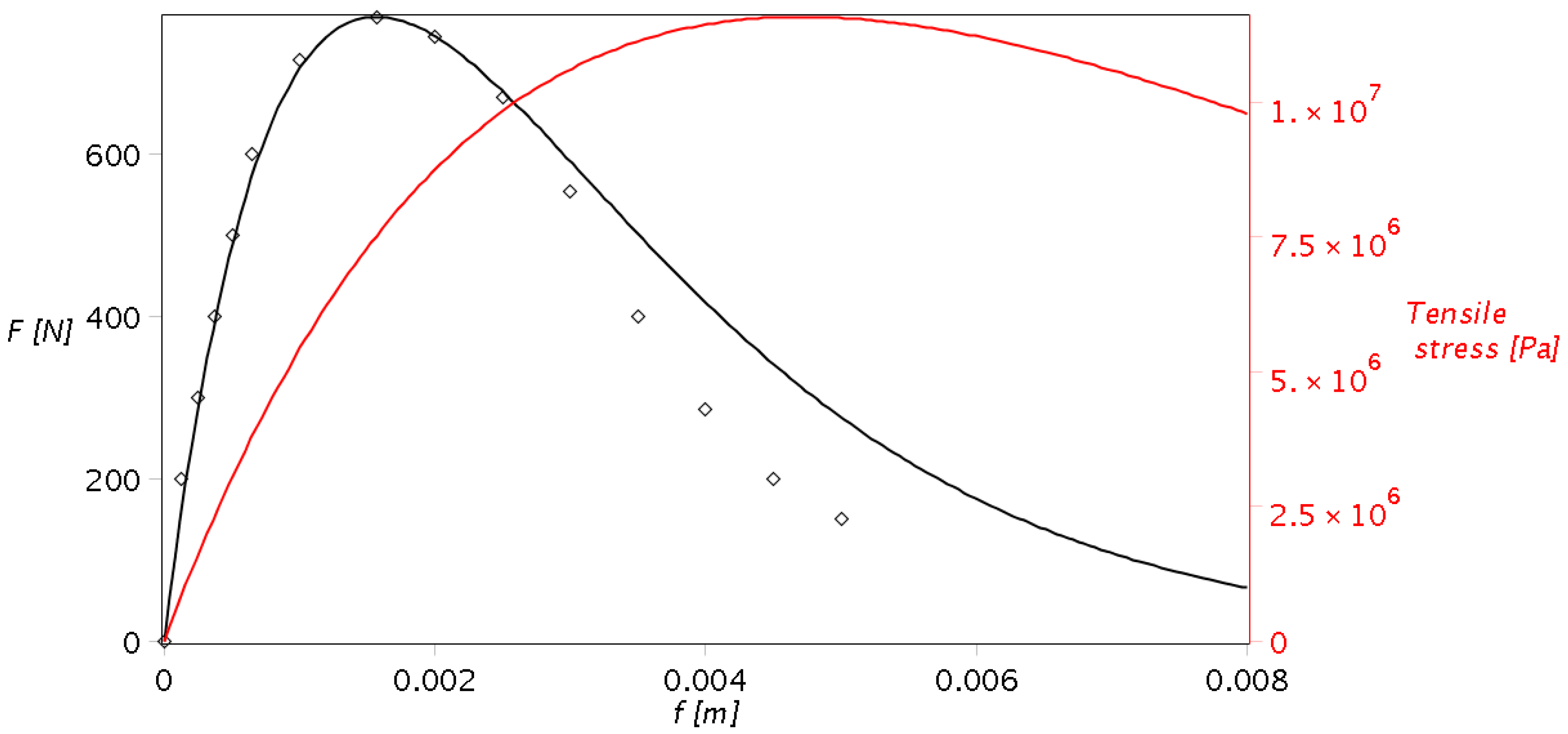Analysis of Concrete Failure on the Descending Branch of the Load-Displacement Curve
Abstract
:1. Introduction
2. Materials and Methods
2.1. Mechanical Model: A Brief Description
- Concrete is viewed as a structure composed of interacting mesoscale elements.
- The material of each element obeys Hooke’s law.
- The modulus of elasticity, strength and other physical and mechanical properties of the material of each element do not depend on its size and do not change over time.
- With an increase in the external load, and hence displacement, individual mesoscale elements are destroyed, as a result of which the effective area decreases, and the load is redistributed to the elements that remain intact. As a result, the average statistical value of the effective stresses in the material of the remaining intact mesoscale elements increases.
- The destruction of mesoscale elements and their conglomerates leads to a decrease in the effective area and a decrease in the resistance of the macrostructure to external force, which corresponds to the descending branch of the “load - displacement” diagram. However, effective stresses (i.e., stresses in the material of mesoscale elements) increase. The growth of effective stresses is limited by the ultimate strength of the material of mesoscale elements.
- Stresses determined without taking damage into account can be called apparent stresses [12].
- The Poisson effect can cause some growth in the transverse dimensions and a corresponding change in the cross-sectional area of the sample under uniaxial compression. Thus, two trends should be analyzed: first, a decrease in cross-sectional area due to destruction of mesoscale elements and, second, an increase in area due to the Poisson effect.
- The primary source of information for the mathematical description of the model and obtaining numerical results is the load-displacement diagram (Figure 1).
2.2. Mathematical Description of the Mechanical Model
2.2.1. Determination of
2.2.2. Determination of
2.2.3. Determination of
2.2.4. Effective Area, Damage Function and Effective Modulus of Elasticity
2.2.5. Curve Equation
3. Results and Discussion
3.1. Some Features of the Model
3.2. Effective Stress
3.3. Comparison with Experiments Known in the Literature
3.4. Relationship between Load and Displacement and Bending Stress-Strain
4. Conclusions
Funding
Conflicts of Interest
References
- Makul, N. Modern sustainable cement and concrete composites: Review of current status, challenges and guidelines. Sustain. Mater. Technol. 2020, 25, e00155. [Google Scholar] [CrossRef]
- Wangler, T.; Roussel, N.; Bos, F.P.; Salet, T.A.; Flatt, R.J. Digital concrete: A review. Cem. Concr. Res. 2019, 123, 105780. [Google Scholar] [CrossRef]
- Miller, S.A. The role of cement service-life on the efficient use of resources. Environ. Res. Lett. 2020, 15, 024004. [Google Scholar] [CrossRef] [Green Version]
- Tam, V.W.; Soomro, M.; Evangelista, A.C.J. A review of recycled aggregated in concrete applications (2000–2017). Constr. Build. Mater. 2018, 172, 272–292. [Google Scholar] [CrossRef]
- Matos, L.M.; Barros, J.A.; Ventura-Gouveia, A.; Calçada, R.A. Constitutive model for fibre reinforced concrete by coupling the fibre and aggregate interlock resisting mechanisms. Cem. Concr. Compos. 2020, 111, 103618. [Google Scholar] [CrossRef]
- Inácio, M.M.; Lapi, M.; Ramos, A.P. Punching of reinforced concrete flat slabs–Rational use of high strength concrete. Eng. Struct. 2020, 206, 110194. [Google Scholar] [CrossRef]
- Xu, Y.; Chen, H.; Wang, P. Effect of Polypropylene Fiber on Properties of Alkali-Activated Slag Mortar. Adv. Civ. Eng. 2020, 2020, 4752841. [Google Scholar] [CrossRef] [Green Version]
- Shafieifar, M.; Farzad, M.; Azizinamini, A. Experimental and numerical study on mechanical properties of Ultra High Performance Concrete (UHPC). Constr. Build. Mater. 2017, 156, 402–411. [Google Scholar] [CrossRef]
- Wang, X.; Zhang, M.; Jivkov, A.P. Computational technology for analysis of 3D meso-structure effects on damage and failure of concrete. Int. J. Solids Struct. 2016, 80, 310–333. [Google Scholar] [CrossRef]
- Aslani, F.; Jowkarmeimandi, R. Stress–strain model for concrete under cyclic loading. Mag. Concr. Res. 2012, 64, 673–685. [Google Scholar] [CrossRef] [Green Version]
- Kurumatani, M.; Terada, K.; Kato, J.; Kyoya, T.; Kashiyama, K. An isotropic damage model based on fracture mechanics for concrete. Eng. Fract. Mech. 2016, 155, 49–66. [Google Scholar] [CrossRef]
- Liu, D.; He, M.; Cai, M. A damage model for modeling the complete stress-strain relations of brittle rocks under uniaxial compression. Int. J. Damage Mech. 2018, 27, 1000–1019. [Google Scholar] [CrossRef]
- Gao, Y.; Ren, X.; Zhang, J.; Zhong, L.; Yu, S.; Yang, X.; Zhang, W. Proposed Constitutive Law of Uniaxial Compression for Concrete under Deterioration Effects. Materials 2020, 13, 2048. [Google Scholar] [CrossRef]
- Stojković, N.; Perić, D.; Stojić, D.; Marković, N. New stress-strain model for concrete at high temperatures. Teh. Vjesn. 2017, 24, 863–868. [Google Scholar] [CrossRef] [Green Version]
- Benin, A.V.; Semenov, A.S.; Semenov, S.G.; Beliaev, M.O.; Modestov, V.S. Methods of identification of concrete elastic-plastic-damage models. Mag. Civ. Eng. 2017, 76, 279–297. [Google Scholar] [CrossRef]
- Liu, X.; Wu, T.; Liu, Y. Stress-strain relationship for plain and fibre-reinforced lightweight aggregate concrete. Constr. Build. Mater. 2019, 225, 256–272. [Google Scholar] [CrossRef]
- Furamura, F. Stress-strain curve of concrete at high temperatures. Trans. Archit. Inst. Jpn. 1966, 7004, 686. [Google Scholar]
- Baldwin, R.; North, M.A. Stress-strain curves of concrete at high temperature—A review. Fire Saf. Sci. 1969, 785, 1. Available online: http://www.iafss.org/publications/frn/785/-1/view/frn_785.pdf (accessed on 10 October 2020).
- Sevostianov, I.; Levin, V.; Radi, E. Effective properties of linear viscoelastic microcracked materials: Application of Maxwell homogenization scheme. Mech. Mater. 2015, 84, 28–43. [Google Scholar] [CrossRef]
- Li, Y.; Chen, Y.F.; Zhou, C.B. Effective stress principle for partially saturated rock fractures. Rock Mech. Rock Eng. 2016, 49, 1091–1096. [Google Scholar] [CrossRef]
- Mao, X.; Liu, Y.; Guan, W.; Liu, S.; Li, J. A new effective stress constitutive equation for cemented porous media based on experiment and derivation. Arab. J. Geosci. 2018, 11, 337. [Google Scholar] [CrossRef]
- Koniki, S.; Prasad, D.R. Mechanical properties and constitutive stress-strain behaviour of steel fiber reinforced concrete under uni-axial stresses. J. Build. Pathol. Rehabil. 2019, 4, 6. [Google Scholar] [CrossRef]
- Zhou, Y.; Liu, J.; Yang, H.; Ji, H. Failure Patterns and Energy Analysis of Shaft Lining Concrete in Simulated Deep Underground Environments. J. Wuhan Univ. Technol. Mater. Sci. Ed. 2020, 35, 418–430. [Google Scholar] [CrossRef]
- Lemery, J.; Ftima, M.B.; Leclerc, M.; Wang, C. The disturbed fracture process zone theory for the assessment of the asymptotic fracture energy of concrete. Eng. Fract. Mech. 2020, 231, 107022. [Google Scholar] [CrossRef]
- Gavrilov, T.A.; Kolesnikov, G.N. Evolving crack influence on the strength of frozen sand soils. Mag. Civ. Eng. 2020, 94, 54–64. [Google Scholar] [CrossRef]
- Ahmed, M.; Liang, Q.Q.; Patel, V.I.; Hadi, M.N. Local-global interaction buckling of square high strength concrete-filled double steel tubular slender beam-columns. Thin-Walled Struct. 2019, 143, 106244. [Google Scholar] [CrossRef]
- Alatshan, F.; Osman, S.A.; Hamid, R.; Mashiri, F. Stiffened concrete-filled steel tubes: A systematic review. Thin-Walled Struct. 2020, 148, 106590. [Google Scholar] [CrossRef]
- Micelli, F.; Cascardi, A.; Aiello, M.A. A Study on FRP-Confined Concrete in Presence of Different Preload Levels. In Proceedings of the 9th International Conference on Fibre-Reinforced Polymer (FRP) Composites in Civil Engineering—CICE, Paris, France, 17–19 July 2018; p. 493. [Google Scholar]







| Number of Samples: | 1 | 2 | 3 | 4 | 5 | 6 | 7 | 8 | 9 |
|---|---|---|---|---|---|---|---|---|---|
| Fiber volume, % | 0.00 | 0.50 | 0.75 | 1.00 | 0.00 | 0.50 | 0.75 | 1.00 | 1.25 |
| , MPa [22] | 28.19 | 29.34 | 29.94 | 30.87 | 54.65 | 54.86 | 57.94 | 59.82 | 56.91 |
| , mε; [22] (1 mε = 0.001) | 1.950 | 2.657 | 2.931 | 2.954 | 2.050 | 3.08 | 3.000 | 3.080 | 3.080 |
| , MPa, (13) (if = ) | 76.63 | 79.75 | 81.39 | 83.91 | 148.55 | 149.12 | 157.50 | 162.61 | 154.70 |
| , MPa; (8) | 39,297 | 30,017 | 27,767 | 28,407 | 72,465 | 48,417 | 52,499 | 52,795 | 50,226 |
| , MPa; [22] | 25,260 | 25,090 | 25,900 | 25,990 | 45,210 | 46,570 | 47,160 | 47,400 | 46,540 |
| 1, MPa; [18] | 31,515 | 24,073 | 22,269 | 22,782 | 58,116 | 38,829 | 42,103 | 42,340 | 40,280 |
© 2020 by the author. Licensee MDPI, Basel, Switzerland. This article is an open access article distributed under the terms and conditions of the Creative Commons Attribution (CC BY) license (http://creativecommons.org/licenses/by/4.0/).
Share and Cite
Kolesnikov, G. Analysis of Concrete Failure on the Descending Branch of the Load-Displacement Curve. Crystals 2020, 10, 921. https://doi.org/10.3390/cryst10100921
Kolesnikov G. Analysis of Concrete Failure on the Descending Branch of the Load-Displacement Curve. Crystals. 2020; 10(10):921. https://doi.org/10.3390/cryst10100921
Chicago/Turabian StyleKolesnikov, Gennadiy. 2020. "Analysis of Concrete Failure on the Descending Branch of the Load-Displacement Curve" Crystals 10, no. 10: 921. https://doi.org/10.3390/cryst10100921
APA StyleKolesnikov, G. (2020). Analysis of Concrete Failure on the Descending Branch of the Load-Displacement Curve. Crystals, 10(10), 921. https://doi.org/10.3390/cryst10100921





